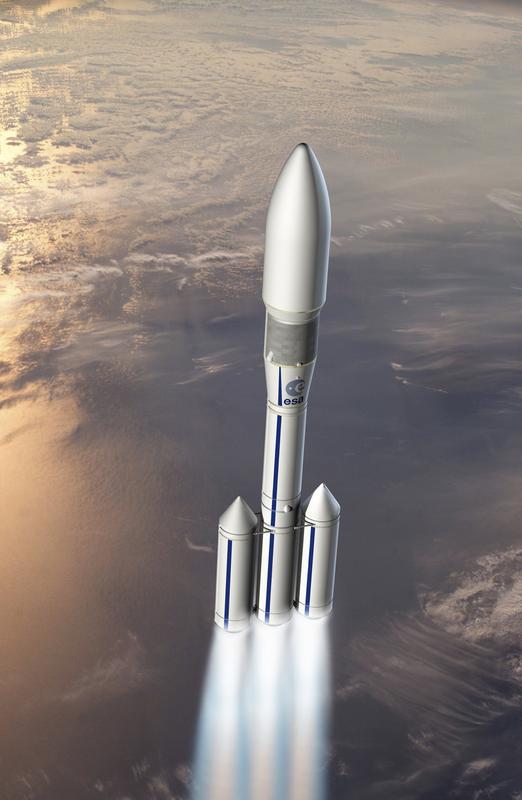Laser for rocket ignition: Carinthian research centre wins contract for space research

Ariane 6 – here in a computer simulation – is scheduled for use as ESA’s new rocket launcher in 2020. © ESA/Airbus
The European Space Agency (ESA) has awarded the Carinthian research centre CTR in cooperation with the German-French company Airbus Safran Launchers GmbH the contract to further develop CTR’s HiPoLas® laser ignition technology for launcher drive systems.
In previous projects with research carried out on test benches at the German Aerospace Centre (DLR), the CTR team already proved highly successfully that the HiPoLas® laser system is suitable for igniting rocket engines. What the new research contract involves is making the system fit for space and thus helping to develop a new generation of European launch vehicles. The research contract has a volume of around 700 thousand euros.
SYSTEM INTEGRATION FIT FOR SPACE
“For us this is unique recognition of the research and development work we have been doing over the past few years. In close cooperation with our partners we have adapted the HiPoLas® laser ignition system many times to various different piston engines for cars and to deliver power for turbines in planes and most recently for engines in satellites and launchers.
The system has also successfully undergone extensive testing. We now intend to integrate the ignition system in a combustion chamber for cryogenic fuels and adapt it to the extreme demands required for subsequent use in space,” says CTR project manager Gerhard Kroupa. This means the materials, components and the complete system including electronics have to meet the complex technical specifications and high quality standards for space travel.
Given the extreme mechanical loads during launch and the very high temperatures and pressures in the combustion chamber, great demands are placed on the system’s robustness. In addition to durability, the researchers also aim to improve cost efficiency over conventional ignition systems.
Depending on the results of the development project, the laser ignition system could also be taken into consideration in ongoing development of the Ariane 6 launcher. Scheduled for 2020, Ariane 6’s maiden flight will, according to ESA, continue to secure “Europe’s access to space”.
MINITURISED LASER IGNITION SYSTEM
CTR researches into compact, diode-pumped solid-state lasers and ignition systems as well as their integration in various industrial applications. Miniaturising the laser source, which does not require any adjustable elements at all and can therefore withstand extreme temperatures and vibrations, has several advantages: a high degree of flexibility regarding the position of the ignition plasma inside the combustion chamber and a much higher pulse power compared with electrical ignition systems enable more reliable ignition even with complex mixture ratios and high fuel velocities. In addition to successful trials in car and stationary large gas engines, the laser source has also been tested for aviation use in jet engines.
ABOUT CTR
As a research centre for smart sensors and system integration, CTR is one of a few non-university research facilities in Austria. Its mission and goal is to develop advanced products and processes based on integrated sensors, micro and nano systems. Established in 1997, CTR conducts research in regional, national and international R&D projects, is a member of Forschung Austria and has filed countless patents with partners in science and industry. CTR is part of Austria’s COMET research programme with the ASSIC centre of excellence – Austrian Smart Systems Integration Research Center.
Media Contact
All latest news from the category: Physics and Astronomy
This area deals with the fundamental laws and building blocks of nature and how they interact, the properties and the behavior of matter, and research into space and time and their structures.
innovations-report provides in-depth reports and articles on subjects such as astrophysics, laser technologies, nuclear, quantum, particle and solid-state physics, nanotechnologies, planetary research and findings (Mars, Venus) and developments related to the Hubble Telescope.
Newest articles

Peptides on Interstellar Ice
A research team led by Dr Serge Krasnokutski from the Astrophysics Laboratory at the Max Planck Institute for Astronomy at the University of Jena had already demonstrated that simple peptides…

A new look at the consequences of light pollution
GAME 2024 begins its experiments in eight countries. Can artificial light at night harm marine algae and impair their important functions for coastal ecosystems? This year’s project of the training…

Silicon Carbide Innovation Alliance to drive industrial-scale semiconductor work
Known for its ability to withstand extreme environments and high voltages, silicon carbide (SiC) is a semiconducting material made up of silicon and carbon atoms arranged into crystals that is…





















